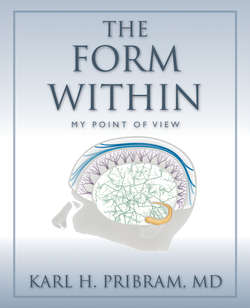Читать книгу The Form Within - Karl H Pribram - Страница 14
На сайте Литреса книга снята с продажи.
Inaugural Experiments
ОглавлениеLashley and I decided to engage in experiments that addressed this issue. Lashley resected small strips of cortex, a cyto-architectural (cellular architectural) unit, while I chose to remove, in one session, practically all of a region that had a non-sensory input from the thalamus.
To anticipate—the results were as might be expected: Lashley was delighted to show that his resections had no effect whatsoever on the behavior of his monkeys, while my resections produced various sensory-related effects that had to be analyzed anatomically, neurophysio- logically, and behaviorally by further experimentation.
I began my research by asking what might be the functions of the so-called silent areas of the brain cortex. Both in the clinic and in the experimental laboratory vast areas of cortex failed to yield their secrets. When tumors or vascular accidents damaged these regions, no consistent results were observed, and when electrical excitation was applied to the regions, no results at all were obtained.
The clinical evidence especially was puzzling. Sometimes, cognitive deficits were obtained, and these were attributed to associations that occurred between sensory inputs or between sensory inputs and higher-order brain processes. The deficits were always sensory specific: for instance, visual, tactile, or auditory (called “aphasia” when restricted to speech). As von Monikov pointed out in 1914, this raised the problem as to whether such deficits were always due to simultaneous involvement of the “silent” cortex and the sensory-specific cortex, or whether they could be produced by damage to the silent cortex alone. I set out to resolve this issue by working with selective removals of the silent cortex in monkeys without damaging the primary sensory input to the brain.
The term “association” was given to these silent cortical areas during the 1880s by Viennese neurologists because, in patients, damage, when it was extensive, resulted in cognitive disturbances that were not obtained when damage was restricted to regions that received one or another specific sensory input. The Viennese neurologists were intellectually aligned with British “associationist” philosophy. The British philosophers and, consequently, the Viennese neurologists, claimed that higher-order mental processes such as cognition are patched together in the brain by association from lower-order sensory processes such as vision, audition, tactile and muscle sensibilities. This view is still dominant in British and American neuroscience and philosophy.
Against the “associative” view is the fact that the cognitive disturbances are most often selectively related to one or another sensory modality. This observation led Sigmund Freud to coin the term “agnosia” (failure to know) as a modifier for such cognitive disturbances: for instance, visual agnosia, tactile agnosia. Freud did not share the associationist view. He proposed an alternative, an analysis of differential processing, in his classical book On Aphasia.
